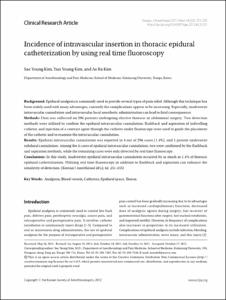KUMEL Repository
1. Journal Papers (연구논문)
1. School of Medicine (의과대학)
Dept. of Anesthesiology & Pain Medicine (마취통증의학)
Incidence of intravascular insertion in thoracic epidural catheterization by using real time fluoroscopy
- Keimyung Author(s)
- Kim, Sae Young; Kim, Ae Ra
- Journal Title
- Korean Journal of Anesthesiology
- Issued Date
- 2012
- Volume
- 62
- Issue
- 3
- Keyword
- Analgesia; Blood vessels; Catheters; Epidural space; Thorax
- Abstract
- Background: Epidural analgesia is commonly used to provide several types of pain relief. Although this technique has been widely used with many advantages, currently the complications appear to be increasing. Especially, inadvertent intravascular cannulation and intravascular local anesthetic administration can lead to fatal consequences. Methods: Data was collected on 296 patients undergoing elective thoracic or abdominal surgery. Two detection methods were utilized to confirm the epidural intravascular cannulation; flashback and aspiration of indwelling catheter, and injection of a contrast agent through the catheter under fluoroscopy were used to guide the placement of the catheter and to examine the intravascular cannulation. Results: Epidural intravascular cannulation was reported in 4 out of 296 cases (1.4%), and 1 patient underwent subdural cannulation. Among the 4 cases of epidural intravascular cannulation, two were confirmed by the flashback and aspiration methods, while the remaining cases were only detected by real time fluoroscopy. Conclusions: In this study, inadvertent epidural intravascular cannulation occurred by as much as 1.4% of thoracic epidural catheterization. Utilizing real time fluoroscopy in addition to flashback and aspiration can enhance the sensitivity of detection.
- Publisher
- School of Medicine
- Citation
- Sae Young Kim et al. (2012). Incidence of intravascular insertion in thoracic epidural catheterization by using real time fluoroscopy. Korean Journal of Anesthesiology, 62(3), 251–255. doi: 10.4097/kjae.2012.62.3.251
- Type
- Article
- ISSN
- 2005-6419
- Appears in Collections:
- 1. School of Medicine (의과대학) > Dept. of Anesthesiology & Pain Medicine (마취통증의학)
- 파일 목록
-
-
Download
 oak-aaa-03399.pdf
기타 데이터 / 169.76 kB / Adobe PDF
oak-aaa-03399.pdf
기타 데이터 / 169.76 kB / Adobe PDF
-
Items in Repository are protected by copyright, with all rights reserved, unless otherwise indicated.